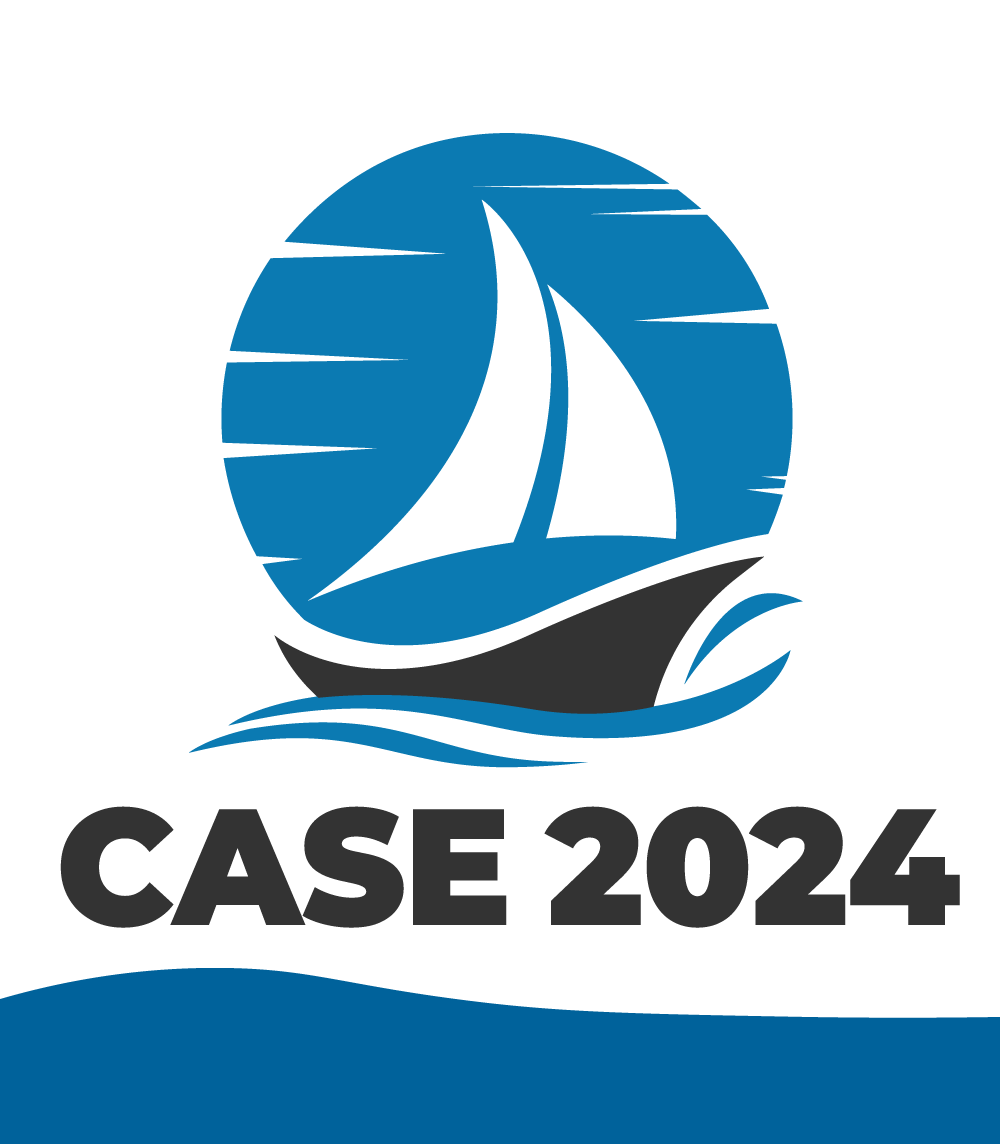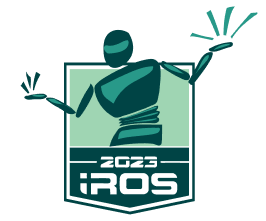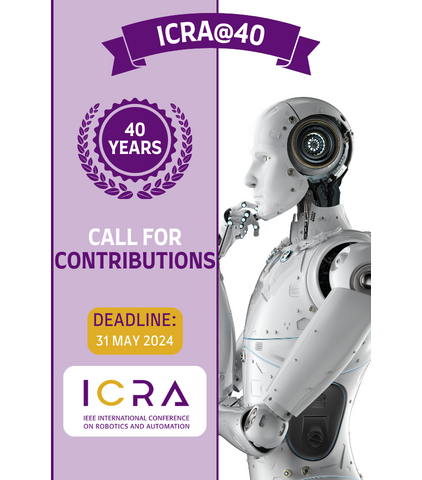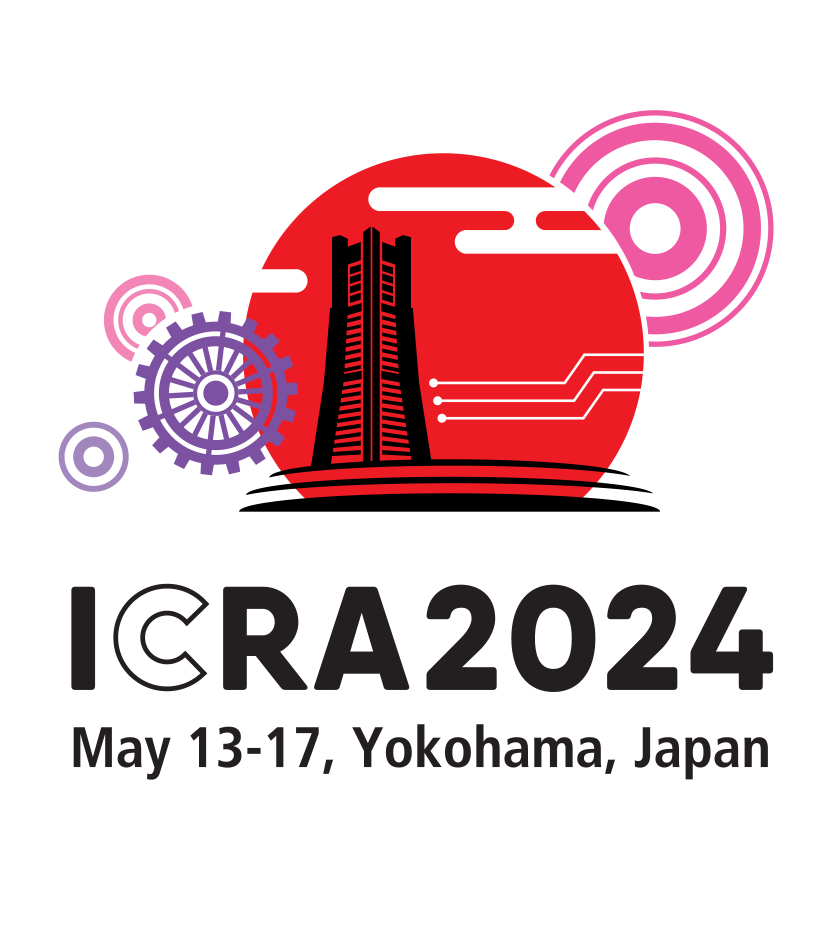Information for Authors
The IEEE Robotics & Automation Magazine is a unique technology publication which is peer-reviewed, readable and substantive. Published continuously since 1994 it is consistently ranked amongst the top four robotics publications in terms of impact factor.
The Magazine is a forum for articles which fall between the academic and theoretical orientation of scholarly journals and vendor sponsored trade publications. The IEEE Transactions on Robotics and the IEEE Transactions on Automation Science and Engineering publish advances in theory and experiments that underpin the science of robotics and automation. The Magazine complements these publications and seeks to present new scientific results to the practicing engineer through a focus on working systems.
The Magazine publishes the following types of articles:
- Regular technical articles that undergo a peer review process overseen by the Magazine's associate editors. Such articles can be submitted at any time by following the instructions below and are published on a first-in, first-out basis.
- Special issues on current topics such as space robots, underwater robots and ethics. These issues are managed by guest editors and a call for papers is published. All articles are fully reviewed as for regular technical articles.
- Tutorial articles written by leading experts in their field.
- Survey articles on emerging themes
- Regular columns on topics such as education, industry news, IEEE RAS news, IFRR news, regional activity and opinion pieces.
- Reproducible Articles (‘R-Articles’): articles reporting on experiments that claim that they can be fully reproduced
- Short Replication Articles (r-articles) reporting on the replication of the results of a published Reproducible Article (‘R-Articles’)
- Short Reply articles where original authors comment on the results obtained by reproducing their published experiments
Instructions for Authors
The Process: Initial Submission to Publication
Submitting a Previously Published Conference Paper
Submitting Final Camera-Ready Manuscripts
Presenting your RAM paper at IEEE RAS Conferences
Reproducible Articles, Short r-articles, Reply Articles
These instructions apply to regular technical articles and contributions to an announced special issue. See below for specific instructions on Open Access and Reproducible Articles.
1. ORCID (Open Researcher and Contributor ID)
All IEEE journals require an Open Researcher and Contributor ID (ORCID) for all authors. ORCIDs enable accurate attribution and improved discoverability of an author’s published work. The author will need a registered ORCID in order to submit a manuscript or review a proof in this journal.
Follow these steps to link a PaperCept account to a registered ORCID. Note that PINs from different sub-domains can be linked to a single ORCID.
- Go to the start page of the PaperCept subdomain where you have an existing PIN (if you do not have one, please create one by following the PIN link from the PaperCept subdomain of interest).
- If you do not already have an ORCID, follow the link “Register an ORCID,” create an ORCID and return to the PaperCept login page.
- Follow the link “Register your ORCID with any of your PaperCept PINs,” enter your registered email or the ORCID and password and then click on Authorize.
- Once you authorize the ORCID to be linked to your PIN you will be returned to the PaperCept subdomain from where you accessed ORCID.
- Follow “Log in to any account associated with this ORCID” to complete associating your PIN to the ORCID.
- If you have inadvertently created multiple PINs in the same subdomain, you can associate all PINs with the same ORCID.
2. Preparing Your Manuscript
Submitted papers must be written in good understandable English. It is not the job of reviewers, associate editors or editor-in-chief to correct English spelling and grammar, and poorly written papers stand a much lower chance of being accepted. Authors wishing for assistance in this regard may consider using the IEEE proof editing service (fee based).
The submitted paper is submitted as a PDF file for review. Magazine templates are available in the format of Latex and Word at IEEE Template Selector (https://template-selector.ieee.org/secure/templateSelector/publicationType). You might like to use the IEEE PDF checker to ensure that your file is compliant, and some hints on creating compliant PDF files using LaTeX. The IEEE Author Center has many helpful links including tools for correct reference formats.
A technical feature (regular or special issue) should meet the following requirements:
- No more than 9 magazine pages, so aim for no more than 4500 words of text
- No more than 10 equations
- No more than 20 references, unless it is a survey article
- No more than 10 figures
- Include at least one high quality color photograph of the robotic system
- Figures, tables, schematics, plots are very welcome
- PLEASE NOTE: figures need to be submitted in high-resolution, high-quality format such as JPEG, TIFF, EPS, etc. PDF files are not supported.
Be aware that mandatory page charges of USD 250 apply for every published page beyond 9 pages with a maximum 7 extra pages at a charge. If your paper has multimedia material then this should be prepared according to the guidelines and submitted at the same time as your PDF file.
If you have not previously submitted a paper to the magazine, you are strongly encouraged to peruse recent issues to familiarize yourself with the style and technical level of typical articles.
Word Count
Most authors are accustomed to writing to a page limit rather than a word limit. Since all magazine articles are retype set it is better to aim for a word limit, however unusual or odd this might feel. If you're working in Word then life is easy, use the word count option from the Tools menu. If you're using LaTeX then your options are:
- detex paper.tex | wc -w
- pdf2ascii paper.pdf | wc –w
The former won't pick up references, both will count equations, but you shouldn't be having too many of these anyway.
3. Submitting Your Manuscript
Prepare your paper in the form of a self-contained pdf file (with the extension .pdf). The maximum file size is 2 MB.
- Follow the link Log in and log in with your PIN (or Login alias) and password. See the section PIN and Login Alias if you do not have a PIN and password.
- On your Access page, use the link Test your PDF manuscript file before submission to check that your file is compliant.
- On your Access page, follow the link Submit a new paper to IEEE-RAM.
- Choose the kind of submission and follow the menus. For a special issue, choose the appropriate Guest editor in the submission page. In all other cases submit to the Editor in Chief.
- Complete the required steps.
- If you have coauthors then you will be asked to enter their PINs. You may look up these PINs on the spot, or create new PINs for them if necessary. Nevertheless it might be a good idea to check ahead of time with your coauthors if they already have PINs, and to ask them to register their PINs themselves if they do not.
- You must submit a copyright release before the paper can be sent out for review.
- After successfully submitting the paper you will receive an acknowledgement by e-mail.
- You may expect to see the status of your paper change over time from "Received" to "Under review" and eventually to "Decision pending." You may also update your contact information whenever necessary.
4. Submitting a Previously Published Conference Paper
The Robotics & Automation Magazine will consider submissions for which earlier versions of the work may have appeared in an IEEE-sponsored conference proceedings. However, for such submissions, the paper must not be just a mere extension of the conference proceedings paper filling in, e.g., details of proofs or additional corollaries, additional experiments, or more detailed background and narrative. Rather, the journal submission must contain new results of substantive research significance and impact beyond the conference version. The authors must make clear in the text of the paper the importance and research significance of these additional results, including any changes and additions to the original material presented in the conference version. Sources must be indicated during the submission procedure and explicitly cited in the manuscript. If the copyright holder of the conference paper is not IEEE, authors should also be aware of potential infringement in case of major overlap in material with the paper submitted to the Robotics & Automation Magazine. Moreover, keep in mind the style of a conference proceeding is different compared to the magazine-style. Previously published conference paper should be submitted as "Evolved Paper".
This modified policy is in place to comply with IEEE guidelines on reducing as much as possible the overlap between conference and journal publications archived in IEEE Xplore, and also to reduce the phenomenon of split citations between the conference and journal versions of the paper. Moreover, the Robotics and Automation Letters (RA-L) now allows for direct publication of a conference paper in an archival journal; authors who may be planning to submit a conference version and later extend it to a journal submission are strongly urged to instead submit their work to RA-L (unless if the new material added to the journal version meets our earlier requirements for research significance and importance).
The Magazine will NOT consider submissions that are currently under review for a conference; such submissions will be returned immediately without review.
5. Decision
In due course the editor-in-chief, on behalf of the associate editor who handles your paper will notify you about the publication decision. The magazine aims to get first decisions back within 90 days. The decision will be one of:
- Accept: The paper is suitable for publication. See Submitting Final Camera-Ready Manuscripts.
- Conditionally accept. The paper has significant promise but is not yet suitable for publication. It will need to be revised. See Revising a Manuscript.
- Revise and resubmit. The paper is not suitable for publication but has some potential. You can choose to revise the article based on reviewer comments and resubmit it, see Revising a Manuscript. Still keep the word count under the limit. A second decision “revise and resubmit" is not allowed, so only (conditionally) accept or reject.
- Reject: The paper, in its current form, is not suitable for publication in the magazine.
- Editorial Reject: The paper is not deemed to be within the scope of the magazine.
Revising an article
If the associate editor who handles your paper requests you to revise and resubmit your paper, please do the following:
- Prepare a response to the comments of the reviewers, Associate Editor and Editor in the form of a text file (with the extension .txt) or pdf file (with the extension .pdf). Without this response you cannot upload the resubmission
- Follow the link Log in and log in with your PIN (or Login alias) and password. See the section PIN and Login Alias if you do not have a PIN and password.
- On the Access page use the link pdf test to check that your pdf files are compliant.
- On your Access page, enter your Author workspace.
- Locate your paper on your Author workspace page and click on the link Resubmit.
- Follow the required steps.
- After resubmitting the paper you will receive an acknowledgement by e-mail.
- Again you may expect to see the status of your paper change from "Received" to "Under review" and eventually to "Decision pending" until you hear from the Editor who handles your paper.
6. Submitting Final Camera-Ready Manuscripts
If the editor-in-chief invites you to prepare and submit your paper in final form then it must be prepared for transmission to the IEEE publications department. All articles for the Magazine are typeset by the IEEE to ensure they are formatted correctly. Please follow the guidelines below.
- Prepare a revised version of the paper in PDF format in accordance with the instructions of the Editor. This file is for cross-checking only and will not be used for the final publication.
- Respect the page limits for the magazine.
- Prepare the source files of the paper for submission. IEEE can accept manuscripts in a variety of formats including For best Word (.doc format), ASCII, Rich Text Format (.rtf format) instructions may be found here. Pack the file or files in a single compressed file with the extension .zip.
- Include the original graphics files as separate high-resolution files and NOT included in a Word file. The minimum resolution should be 300 dpi for the desired final print size. Ensure that you have permission to use any picture you may be using: it is not legal to just get a picture from the WWW from other authors, for example. Clearly state in your letter to the editor that all used graphics have been cleared from any copyright issues which may be involved.
- On the PaperCept website, follow the link Log in and log in with your PIN (or Login alias) and password.
- On your Access page, enter your Author workspace.
- If the previous version of your paper was submitted under the old system (before October 31, 2008) then you may not find your paper in your Author workspace. In this case you will need to use the Legacy login link on the Access page. The e-mail message that you received from the Editor has full instructions.
- Locate your paper on your Author workspace page and click on the link Submit final version.
- Complete the required steps.
- After submitting the final version you will receive an acknowledgement by e-mail.
- After the paper has been forwarded to the publishers you will be contacted by e-mail about the copyright form and the proofs.
- IMPORTANT: please note that the TITLE of your paper will be edited to make it catchy, short, clear and appealing to most RAM readers. So, the new Title may not correspond to the one that you proposed in your final manuscript, but you will be notified of the new title at the time of proof correction. Also, a SUBTITLE will be proposed and included in the fully edited version of your manuscript. In case you plan to post a draft version of your paper on websites before its publication, be aware that the possible change of the title in the final manuscript could make some early citations of the draft version of your paper not fully consistent with the final Xplore citation data.
7. Publication
A regular paper joins the publication queue and will be scheduled to an issue as space becomes available, and this can be up to 12 months after submission of camera ready manuscript. You will be contacted by IEEE with a galley proof of your article about 6 weeks before the cover date and you have 5 days to respond.
A paper accepted for a special issue has a known publication date, but the final manuscript must be submitted by the date advised by the editor-in-chief. Failing to meet this deadline means your paper will miss the special issue and go to the end of the regular paper queue.
You can post a copy of your submitted paper (not the final formatted version) on your own web server as discussed below.
Rapid Posting
Papers are now rapid posted prior to appearance in the print/digital issue. These papers are on IEEE Xplore, have a DOI and can be found by Xplore or Google search. They don't have a volume/issue/page number but are otherwise fully citable. You can find such papers via the "Early Access" button on the Magazine's Xplore page.
8. Presenting Your Robotics & Automation Magazine Paper at IEEE RAS Conferences
Any IEEE Robotics & Automation Magazine (RAM) paper, may be presented at one of the upcoming conferences of the IEEE Robotics and Automation Society (RAS): IEEE International Conference on Robotics and Automation (ICRA), IEEE/RSJ International Conference on Intelligent Robots and Systems (IROS), and IEEE International Conference on Automation Science and Engineering (CASE), provided most of the key ideas of the paper have never appeared at a conference with a published proceedings (i.e., the paper is a “new” paper and not the evolved version of a previous conference paper or papers).
Authors of accepted RAM papers will be given the option to select a conference at which they wish to present. Authors can present at only one conference and therefore will only be able to select one of the following options. Conference options will be open for a period of time only and will close a month before the Senior Program Committee Meeting of each conference.
- ICRA 20xx+1: To be eligible for ICRA 20xx+1, your paper’s final accepted manuscript must be submitted to RAM for proofing between March 1, 20xx, and November 30, 20xx.
- IROS 20xx+1: To be eligible for IROS 20xx+1, your paper’s final accepted manuscript must be submitted to RAM for proofing between August 1, 20xx, and April 30, 20xx+1.
- CASE 20xx+1: To be eligible for CASE 20xx+1, your paper’s final accepted manuscript must be submitted to RAM for proofing between August 1, 20xx and April 30, 20xx+1.
Authors may not request any acceleration or delay of the review process based on these criteria.
Authors of eligible papers will be notified within the PaperCept submission platform and can determine their interest in presenting at a conference. Eligible papers may only be presented at one conference.
9. Frequently Asked Questions
PIN and Login Alias
To log in to the IEEE RAM and review system authors, reviewers and editorial staff need a PIN (Personal Identification Number) and a password. IEEE RAM uses the people database of the RAS Conference system so if you have a PIN in this database then you may use this to log in to IEEE RAM. If you already have a PIN and password then follow the link Log in. If you do not remember your PIN or password, or you are not sure if you have a PIN, then follow the link PIN.
- Use the PIN Wizard to check very carefully if you already have a PIN.
- If you do have a PIN but you do not have your password, then request that the password be sent to you.
- If your e-mail address for the PIN is out of date and you cannot receive the password, then do not register a new PIN but request that your e-mail address is updated and your password be sent to you at the updated e-mail address.
- Only register a new PIN if you are completely sure that you do not already have one.
Generally only authors who are new to the system will need to register a new PIN. We strongly recommend against registering multiple PINs. If you use the update function of the PIN wizard you may set up a Login alias. You may use this to log in instead of your PIN. You may also change your password as you like. However, when you submit a paper you will still need the PIN.
Color
Authors are encouraged to submit high quality, high resolution color photographs and illustrations when appropriate. The magazine is printed in full color and there is no additional cost to authors for the use of color. Copyright information and photo credit information must be provided for all photographs used in any IEEE publications.
Page Charges
A mandatory page charge is imposed on all Regular Papers whose length exceeds 9 Magazine pages, and this is difficult to estimate since the articles are typeset by the IEEE.
This charge is $250 per page for each page over the first nine based, and with a maximum 7 extra pages, and is a prerequisite for publication. Note that the editor-in-chief can exercise some limited discretion in this regard. Aim for text under 4500 words and a short bibliography of less than 20 references. Do not skimp on images, they are key to the magazine style.
Abstract
Articles in the magazine, unlike the transactions, do not have an abstract. However, we do need an abstract as part of the metadata on IEEE Xplore, so we will use the abstract you provide or the first paragraph of the article. This is what you see on the summary page for your article in Xplore.
Posting Papers on Your Own Website
IEEE policy retains substantial rights for authors to post on their personal sites and their institutions' servers, but only the accepted versions of their papers, not the published versions as might be downloaded from IEEE Xplore. Click here for details on the policy. See also the details of IEEE policy on the SHERPA RoMEO site where you can compare IEEE's policy with that of many other publishers.
Multimedia Extensions in IEEE Xplore
The Magazine allows multimedia attachments to the paper which are available, along with the PDF article, on IEEE Xplore. Multimedia can be "playable" files (.mpeg, .avi, .wav, .mov, .midi, etc.) or "dataset" files (e.g., raw data with programs to manipulate them). Such material is intended to enhance the contents of a paper, both in clarity and in added value.
- Please refer to the RAS Video Submission Guidelines
- IEEE also provides guidelines for the submission of multimedia, ranging from the format to the description of content and of use requirements, and the way this material should be referenced in the body of the paper. General guidelines include:
- The paper should be self-contained, i.e., fully readable and understandable independently from the multimedia material.
- A "ReadMe.txt" file (in ASCII text format) should accompany the multimedia, describing:
- Minimum requirements for the user. In particular, provide the version of the software that is required to play/run the submitted files. Include the name of the software, the version number, and any special requirements for the player.
- Contact Information. The author should provide contact information in case users have questions regarding the multimedia material (IEEE will not provide any technical support for this).
- A "Summary.txt" file (in ASCII text format) should also be prepared, describing in 5 sentences or less the contents or value of the multimedia object.
Chinese, Japanese, and Korean (CJK) Author Names
IEEE supports the publication of Chinese, Japanese, and Korean (CJK) author names in the native language alongside the English versions of the names in the author list of an article. For more information, please visit the IEEE Author Center.
Open Access
RAM policies on Open-Access publishing are the same as general IEEE policies. The majority of all IEEE transactions, journals, and letters offer a hybrid option, which permits both traditional subscription-based content as well as open access, author-pays content. For all hybrid journals, the quality of the review process for OA and traditional articles is the same. Any open access papers published within a hybrid journal will be included in all media types offered by that title.
Authors using government research funding or university consortium funding may be required to publish in OA journals. In addition, authors may choose to pay to publish to gain the largest possible audience for their innovative practical, applied and theoretical research.
RAM will allow open-access for those authors who require it and who support publishing costs directly. Any communication regarding the Open Access choice will only be entertained after the final decision about publication, which is totally unaffected. The peer-review process is indifferent to articles being Open-Access or not. Reviewers will not know if an article is OA or not. Authors’ commitment to OA is only made after acceptance.
The open access article processing charge (APC) for this publication is USD $2045 for all articles accepted on or after 1 January 2023. Other applicable fees (e.g. over-length paper charges) remain unchanged.
10. Reproducible Articles (R-Articles), Short Replication Articles (r-articles), Reply Articles
Since September 2017 IEEE Robotics & Automation Magazine solicits R-articles (i.e., papers that report experiments aiming to be fully reproducible), short articles reporting on the replication of r-Article results, and author short article replies, see [5].
All papers are peer reviewed. The result will be a two stage very high-quality review process. The first stage will be the ordinary rigorous review process of a top-tier publishing venue. The second stage will be the replication of the experiments by the community (what is usually the core of the scientific method).
Cover letter
The authors will have to explicitly declare in the cover letter, if their article aims to be considered for publication as Reproducible Article (R-Article), as a short article illustrating the replication of other authors’ results (a ‘r-article’), or a short reply by the authors of a reproduced experiment.
It is the responsibility of the authors to publish all the necessary information to make their results reproducible.
What to put in a RAM R-Article
The authors will have to share whatever they believe is necessary and sufficient to reproduce their results and confirm that in the cover letter.
Minimum Requirements
- A description. i.e., an almost ordinary journal article with text, figures, and multimedia, complying at a minimum with the good experimental methodology (GEM) guidelines, [1], or similar.
- data sets stored in Code Ocean [2], IEEE Dataport [3], GitHub [4] or other suitable platform (to be agreed with RAM EIC and Reproducibility editor), and all the necessary information tests that have been run; only in well justified special cases will we accept different sharing platforms; videos of experiments should not be considered as data sets, but as multimedia attachments if they are not actually part of the data elaborated by some algorithm in the robot software. The statistical measures of confidence (such as ‘p-values’) of the results must be spelled out clearly, calculated and being retrieved on the datasets
- complete code identifiers and preferably downloadable code (executable files might in some cases be enough) on Code Ocean —the algorithms as they have been coded and all necessary library and middleware information. The storage on other suitable platforms must be agreed with RAM EIC and Reproducibility editor.
- a hardware (HW) description or HW identifier (we need to know the physical details of the robots to be able to repeat robotics experiments); by HW description, we mean the full design (at the level of detail necessary for replication) of the robot or robots used in the experiment.
The information in (1-2) and any other the authors deem necessary for reproducing their results must be stored in a specific pdf file as ‘additional online materials.’
It is important that the code and HW are well identified to be able to replicate experiments.
- Is it an experimental paper?
- Are the system assumptions/hypotheses clear?
- Are the evaluation criteria spelled out explicitly?
- What is being measured and how?
- Do the methods and measurements match the criteria?
- Is there enough information to reproduce the work?
- Do the results obtained give a fair and realistic picture of the system being studied?
- Are the drawn conclusions precise and valid?
The Euron GEM guidelines in a nutshell [1]. The guidelines were meant as an adaptation of the basics of the scientific method to robotics and AI.
Typical structure of an R-Article
R-articles should be organized in three parts:
- Magazine Article: It provides a ‘magazine style overview of the published research like any typical RAM article. It should convey the general ideas, motivation, relevance and obtained results.
- Supplemental Information: It provides an extended version of the magazine article. It describes, with sufficient details to allow to reproduce the work, Materials and Methods, Results and their analytical Discussion. The description of the research must be in accordance with the Euron GEM Guidelines [1]. It must provide the user guide for reproducing the results. It will be uploaded as a Multimedia Attachment (this may change in the future),
- Data, Code and Design Repository: an online repository on IEEE DataPort , [3],or Github, [4], includes all the data, code and, if they are open sourced, the hardware designs of the robots involved in the research, if they are not, the necessary information to clearly identify the hardware used for the experiments. All additional details necessary and sufficient to reproduce the experiments must be given. If the published research includes simulations, authors are recommended to store code and data allowing the simulation experiments to be reproduced online on Codeocean, [2].
The R-Article Life Cycle
It will be possible to publish a short article about the result replication of an R-article, what we call an r-article (non-capitalized r).
Similarly, the authors of the original R-article will be able to submit, in the form of a short peer reviewed article, a Reply to the authors of the r-article, we will call this a Reply article.
All these articles will have the same minimum requirements as the R-articles.
Peer Review, Data and Code Consistency Check
All articles above will be peer reviewed like any other RAM article and will undergo a quick data and code consistency check.
Difference with publishing your data and code for a standard peer-reviewed article
Publishing an R-article on RAM is not the same that publishing on another journal and sharing code and data. An R-article is specifically peer-reviewed also from the point of view of its reproducibility. Moreover, it enters into the research reproducibility process described above. This is a unique opportunity at the time of writing these guidelines
[1] F. Bonsignorio, J. Hallam, A. P. del Pobil, Eds. (2008). GEM guidelines: Euron GEM Sig report. [On line]. Available: http://www.heronrobots.com/ EuronGEMSig/downloads/GemSigGuidelines Beta.pdf
[2] CodeOcean. Discover and run scientific code. [Online]. Available: http://www.codeocean.com
[3] IEEE DataPort: Dataset Storage and Dataset Search Platform. [Online]. Available:
[4] Github. [Online]. Available: http://www.codeocean.com
[5] F. Bonsignorio, "A New Kind of Article for Reproducible Research in Intelligent Robotics [From the Field]," in IEEE Robotics & Automation Magazine, vol. 24, no. 3, pp. 178-182, Sept. 2017, doi: 10.1109/MRA.2017.2722918.







